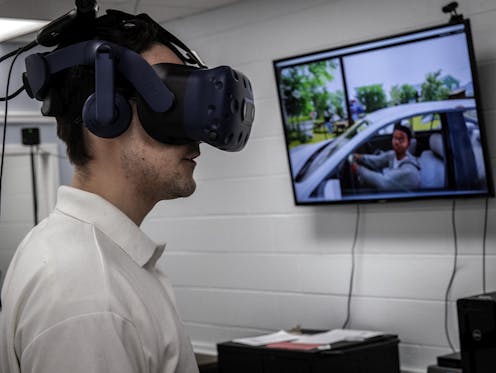5 challenges of doing college in the metaverse
There are benefits to taking college classes in the metaverse, but there are also potential problems.

More and more colleges are becoming “metaversities,” taking their physical campuses into a virtual online world, often called the “metaverse.” One initiative has 10 U.S. universities and colleges working with Meta, the parent company of Facebook, and virtual reality company VictoryXR to create 3D online replicas – sometimes called “digital twins” – of their campuses that are updated live as people and items move through the real-world spaces.
Some classes are already happening in the metaverse. And VictoryXR says that by 2023, it plans to build and operate 100 digital twin campuses, which allow for a group setting with live instructors and real-time class interactions.
One metaversity builder, New Mexico State University, says it wants to offer degrees in which students can take all their classes in virtual reality, beginning in 2027.
There are many benefits to taking college classes in the metaverse, such as 3D visual learning, more realistic interactivity and easier access for faraway students. But there are also potential problems. My recent research has focused on ethical, social and practical aspects of the metaverse and risks such as privacy violations and security breaches. I see five challenges:
1. Significant costs and time
The metaverse provides a low-cost learning alternative in some settings. For instance, building a cadaver laboratory costs several million dollars and requires a lot of space and maintenance. A virtual cadaver lab has made scientific learning affordable at Fisk University.
However, licenses for virtual reality content, construction of digital twin campuses, virtual reality headsets and other investment expenses do add costs for universities.
A metaverse course license can cost universities at least $20,000, and could go as high as $100,000 for a digital twin campus. VictoryXR also charges a yearly subscription fee of $200 per student to access its metaverse.
Additional costs are incurred for virtual reality headsets. While Meta is providing a limited number of its virtual reality headsets – the Meta Quest 2 – for free for metaversities launched by Meta and VictoryXR, that’s only a few of what may be needed. The low-end 128GB version of the Meta Quest 2 headset costs $399.99. Managing and maintaining a large number of headsets, including keeping them fully charged, involves additional operational costs and time.
Colleges also need to spend significant time and resources to provide training to faculty to deliver metaverse courses. Even more time will be required to deliver metaverse courses, many of which will need all-new digital materials.
Most educators don’t have the capability to create their own metaverse teaching materials, which can involve merging videos, still images and audio with text and interactivity elements into an immersive online experience.
2. Data privacy, security and safety concerns
Business models of companies developing metaverse technologies rely on collecting users’ detailed personal data. For instance, people who want to use Meta’s Oculus Quest 2 virtual reality headsets must have Facebook accounts.
The headsets can collect highly personal and sensitive data such as location, students’ physical features and movements, and voice recordings. Meta has not promised to keep that data private or to limit access that advertisers might have to it.
Meta is also working on a high-end virtual reality headset called Project Cambria, with more advanced capabilities. Sensors in the device will allow a virtual avatar to maintain eye contact and make facial expressions that mirror the user’s eye movements and face. That data information can help advertisers measure users’ attention and target them with personalized advertising.
Professors and students may not freely participate in class discussions if they know that all their moves, their speech and even their facial expressions are being watched by the university as well as a big technology company.
The virtual environment and its equipment can also collect a wide range of user data, such as physical movement, heart rate, pupil size, eye openness and even signals of emotions.
Cyberattacks in the metaverse could even cause physical harm. Metaverse interfaces provide input directly into users’ senses, so they effectively trick the user’s brain into believing the user is in a different environment. People who attack virtual reality systems can influence the activities of immersed users, even inducing them to physically move into dangerous locations, such as to the top of a staircase.
The metaverse can also expose students to inappropriate content. For instance, Roblox has launched Roblox Education to bring 3D, interactive, virtual environments into physical and online classrooms. Roblox says it has strong protections to keep everyone safe, but no protections are perfect, and its metaverse involves user-generated content and a chat feature, which could be infiltrated by predators or people posting pornography or other illegal material.
3. Lack of rural access to advanced infrastructure
Many metaverse applications such as 3D videos are bandwidth-intensive. They require high-speed data networks to handle all of the information flowing between sensors and users across the virtual and physical space.
Many users, especially in rural areas, lack the infrastructure to support the streaming of high-quality metaverse content. For instance, 97% of the population living in urban areas in the U.S. has access to a high-speed connection, compared to 65% in rural areas and 60% in tribal lands.
4. Adapting challenges to a new environment
Building and launching a metaversity requires drastic changes in a school’s approach to teaching and learning. For instance, metaverse students aren’t just recipients of content but active participants in virtual reality games and other activities.
The combination of advanced technologies such as immersive game-based learning and virtual reality with artificial intelligence can create personalized learning experiences that are not in real time but still experienced through the metaverse. Automatic systems that tailor the content and pace of learning to the ability and interest of the student can make learning in the metaverse less structured, with fewer set rules.
Those differences require significant modifications in assessment and monitoring processes, such as quizzes and tests. Traditional measures such as multiple choice questions are inappropriate to assess individualized and unstructured learning experiences offered by the metaverse.
5. Amplifying biases
Gender, racial and ideological biases are common in textbooks of history, science and other subjects, which influence how students understand certain events and topics. In some cases, those biases prevent the achievement of justice and other goals, such as gender equality.
Biases’ effects can be even more powerful in rich media environments. Films are more powerful at molding students’ views than textbooks. Metaverse content has the potential to be even more influential.
To maximize the benefits of the metaverse for teaching and learning, universities – and their students – will have to wrestle with protecting users’ privacy, training teachers and the level of national investment in broadband networks.
Nir Kshetri does not work for, consult, own shares in or receive funding from any company or organization that would benefit from this article, and has disclosed no relevant affiliations beyond their academic appointment.
Read These Next
RFK Jr. wants to scrutinize the vaccine schedule – but its safety record is already decades long
Federal officials are questioning the safety of the vaccine series children receive. Here’s the story…
Rest is essential during the holidays, but it may mean getting active, not crashing on the couch
Unwinding can be hard during the holidays for many reasons. Building in time to recharge through active…
What are gas stove manufacturers trying to hide? Warning labels
The gas industry is opposed to labels that warn consumers of the potential harms of gas stoves.





